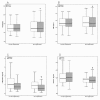The role of soluble fiber intake in patients under highly effective lipid-lowering therapy
- PMID: 21810257
- PMCID: PMC3159132
- DOI: 10.1186/1475-2891-10-80
The role of soluble fiber intake in patients under highly effective lipid-lowering therapy
Abstract
Background: It has been demonstrated that statins can increase intestinal sterol absorption. Augments in phytosterolemia seems related to cardiovascular disease.
Objective: We examined the role of soluble fiber intake in endogenous cholesterol synthesis and in sterol absorption among subjects under highly effective lipid-lowering therapy.
Design: In an open label, randomized, parallel-design study with blinded endpoints, subjects with primary hypercholesterolemia (n = 116) were assigned to receive during 12 weeks, a daily dose of 25 g of fiber (corresponding to 6 g of soluble fibers) plus rosuvastatin 40 mg (n = 28), rosuvastatin 40 mg alone (n = 30), sinvastatin 40 mg plus ezetimibe 10 mg plus 25 g of fiber (n = 28), or sinvastatin 40 mg plus ezetimibe 10 mg (n = 30) alone.
Results: The four assigned therapies produced similar changes in total cholesterol, LDL-cholesterol, and triglycerides (p < 0.001 vs. baseline) and did not change HDL-cholesterol. Fiber intake decreased plasma campesterol (p < 0.001 vs. baseline), particularly among those patients receiving ezetimibe (p < 0.05 vs. other groups), and β-sitosterol (p = 0.03 vs. baseline), with a trend for lower levels in the group receiving fiber plus ezetimibe (p = 0.07). Treatment with rosuvastatin alone or combined with soluble fiber was associated with decreased levels of desmosterol (p = 0.003 vs. other groups). Compared to non-fiber supplemented individuals, those treated with fibers had weight loss (p = 0.04), reduced body mass index (p = 0.002) and blood glucose (p = 0.047).
Conclusion: Among subjects treated with highly effective lipid-lowering therapy, the intake of 25 g of fibers added favorable effects, mainly by reducing phytosterolemia. Additional benefits include improvement in blood glucose and anthropometric parameters.
Figures

References
-
- National Cholesterol Education Program (NCEP) Expert Panel on Detection, Evaluation, and Treatment of High Blood Cholesterol in Adults (Adult Treatment Panel III) final report. Circulation. 2002;106(25):3143–421. - PubMed
-
- Ortega RM, Palencia A, Lopez-Sobaler AM. Improvement of cholesterol levels and reduction of cardiovascular risk via the consumption of phytosterols. Br J Nutr. 2006;96(Suppl 1):S89–93. - PubMed
-
- Assmann G, Cullen P, Erbey J, Ramey DR, Kannenberg F, Schulte H. Plasma sitosterol elevations are associated with an increased incidence of coronary events in men: results of a nested case-control analysis of the Prospective Cardiovascular Munster (PROCAM) study. Nutr Metab Cardiovasc Dis. 2006;16(1):13–21. doi: 10.1016/j.numecd.2005.04.001. - DOI - PubMed
Publication types
MeSH terms
Substances
Supplementary concepts
LinkOut - more resources
Full Text Sources
Medical

